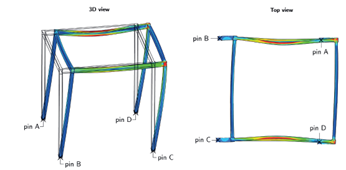
Coupled Instabilities and Resistance of (Steel) Building Structures
As previous research indicated design codes may be non-conservative for certain coupled instabilities, in this project it is tried to (a) specify the conditions for which coupled instabilities and resistance must be considered (next to column buckling and overall buckling, and (b) to come up with some proposals how to assess structures for these situations.
Introduction
Building structures are certainly checked for column buckling and overall buckling (e.g. for high-rise buildings seen as a single column), but often coupled instabilities are believed to be non-existent as long as wind loads can be sustained. However, analogous to the local, distortional, and global buckling of thin-walled structures, potentially building structures can buckle in modes for which parts of the structure become instable, and interact with other parts, these parts sized across the range from single columns to the complete building. In a previous Eindhoven project, interaction of instability and plasticity in steel frames was explored via several case studies. Most case studies made use of a steel 3D sway frame. For these studies, finite element simulations and Eurocode 3 predictions were compared, and it was found that for some cases, Eurocode predictions were non-conservative. Also, it was suggested that the sum of all unity checks within a structure seems to be an important indication for the load capacity. This is interesting, for currently the Eurocode 3 only considers the maximal unity check to determine the ultimate load.


Figure 1, left: building steel structure (alamy.com), right: finite element model for coupled instabilities.
Method
The project will start with a thorough study of the research already carried out at Eindhoven University of Technology, including verification of the finite element simulations and design code predictions. Based on the results, new building structure topologies are designed, inspired by existing structures and tuned to invoke coupled instabilities that are likely to be of interest. In first instance, these topologies will be studied by their Eigenmodes, and Eigenvalues of column buckling, overall buckling and coupled modes will be compared. Then a few of these topologies are designed in steel, and Eurocode predictions will be compared with geometrical and (later) material nonlinear simulations. Finally, a concept journal paper will be improved and extended, serving as the MSc thesis as well.
Requirements
We are looking for an enthusiastic and bright student, interested in the finite element method, (steel) structures, engineering, and design rules, preferably with good grades for the Applied Mechanics courses. A rewarding and state-of-the-art project is offered, which likely will result in a journal paper. The project will be supervised by Dr. Hèrm Hofmeyer (SED) and Prof. Bert Snijder (SED). If you would like to have more information on the project, do not hesitate to contact Dr. Hèrm Hofmeyer, VRT 9.32, 040-247-2203, h.hofmeyer@tue.nl.